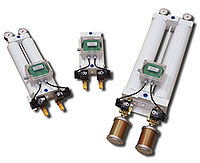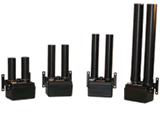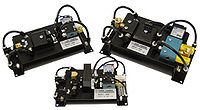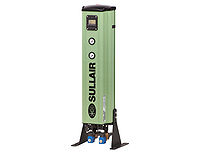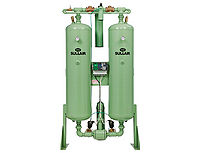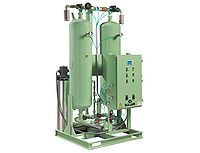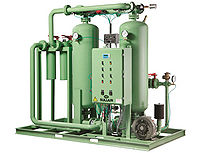Difference between revisions of "Regens"
| Line 5: | Line 5: | ||
* Please start editing this page after the /noinclude | * Please start editing this page after the /noinclude | ||
* -------------------------------------------------></noinclude> | * -------------------------------------------------></noinclude> | ||
The '''Regens''' are used for drying air in | The '''Regens''' are used for drying air in [[Storage Tanks]] or [[Pneumatic Conveying Systems]] and are beneficial in the drying of hygroscopic (water-absorbing) resins. These [[Dryers]] remove water from the air by passing it through a desiccant that absorbs moisture. | ||
==Features== | ==Features== | ||
The Regens consist mainly of two cylinders containing desiccant, connected by a valve system. | The Regens consist mainly of two cylinders containing desiccant, connected by a valve system. | ||
==Operation== | ==Operation== | ||
When | When the desiccant in the first cylinder is saturated, the air flow can be switched to the cylinder containing the dried desiccant. | ||
==Dessicant Types== | ==Dessicant Types== | ||
Common desiccants are silica gel (an oxide of silica), alumina (aluminum | Common desiccants are silica gel (an oxide of silica), alumina (aluminum oxide) and calcium sulfate (the anhydrous form of gypsum). | ||
==Costs== | |||
===Most Expensive=== | |||
Heatless Regens run a portion of dried compressed air through the previously utilized cylinder to extract moisture from its desiccant. | |||
===Least Expensive=== | |||
Heated purge regenerative Regens use less air than the heatless variety in addition to heat, which helps the air carry away more water as it passes through the saturated desiccant. | |||
== | ===Best Compromise=== | ||
Heated blower purge regenerative Regens use air from outside the dryer that is heated and sent through the water-saturated desiccant for drying. | |||
== | ==Types== | ||
There are different types of regenerative regens. These are: | There are different types of regenerative regens. These are: | ||
* Small Heatless Regens | * Small Heatless Regens | ||
| Line 36: | Line 42: | ||
* DBP Desiccant Regenerative Blower Purge Dryer | * DBP Desiccant Regenerative Blower Purge Dryer | ||
==Small Heatless Regens== | ===Small Heatless Regens=== | ||
[[File: | [[File:Small_Heatless_Regens.jpg|thumb|right|200px|Small Heatless Regens]] | ||
Using Pressure Swing Adsorption (PSA) technology, the Twin Tower Engineering regenerative air dryers are designed to maximize the efficiency of the drying process. Ultra-Dry compressed air dew points of -40°F to better than -100°F can be achieved. | Using Pressure Swing Adsorption (PSA) technology, the Twin Tower Engineering regenerative air dryers are designed to maximize the efficiency of the drying process. Ultra-Dry compressed air dew points of -40°F to better than -100°F can be achieved. | ||
==Large Heatless Regens== | ===Large Heatless Regens=== | ||
Engineered for long service life and superior protection of your air-operated equipment and processes. THL series heatless regenerative desiccant compressed air dryers deliver the peace of mind of high quality, value and fast delivery. | Engineered for long service life and superior protection of your air-operated equipment and processes. THL series heatless regenerative desiccant compressed air dryers deliver the peace of mind of high quality, value and fast delivery. | ||
==Compact Heatless Regens== | ===Compact Heatless Regens=== | ||
[[File: | [[File:Compact_Heatless_Regens.gif|thumb|right|200px|Compact Heatless Regens]] | ||
Economical and compact, these heatless desiccant compressed air dryers provide low dew points to -100°F ADP(atmospheric dew point). This proven "no-frills" design uses Pressure Swing Adsorption (PSA) technology and will provide years of trouble-free service. | Economical and compact, these heatless desiccant compressed air dryers provide low dew points to -100°F ADP(atmospheric dew point). This proven "no-frills" design uses Pressure Swing Adsorption (PSA) technology and will provide years of trouble-free service. | ||
==Mini Heatless Regens== | ===Mini Heatless Regens=== | ||
[[File: | [[File:Mini_Heatless_Regens.jpg|thumb|right|200px|Mini Heatless Regens]] | ||
Ultra-small desiccant compressed air dryers can be used for low-flow applications or with fractional horsepower air compressors. These units are heatless regenerative Regens designed to produce low dew points. Extremely small footprint allows for packaging inside equipment cabinets or at point-of-use. | Ultra-small desiccant compressed air dryers can be used for low-flow applications or with fractional horsepower air compressors. These units are heatless regenerative Regens designed to produce low dew points. Extremely small footprint allows for packaging inside equipment cabinets or at point-of-use. | ||
==DMD Desiccant Modular Dryer== | ===DMD Desiccant Modular Dryer=== | ||
[[File: | [[File:DMD_Desiccant_Modular_Dryer.jpg|thumb|right|200px|DMD Desiccant Modular Dryer]] | ||
The Sullair DMD series is a lightweight modular | The Sullair DMD series is a lightweight modular [[Desiccant Dryers|Desiccant dryer]] that offers unsurpassed installation flexibility. This lightweight modular dryer design brings a whole new concept in compressed air technology offering total installation flexibility to meet your specific needs. A small amount of the dried compressed air is used to regenerate the saturated desiccant bed by expanding air from line pressure to atmospheric pressure, removing the moisture absorbed by the desiccant material. Protection is built-in. Extruded aluminum housings that surround the dryers are fully protected from corrosion. | ||
==DHL Desiccant Heatless Dryer== | ===DHL Desiccant Heatless Dryer=== | ||
[[File: | [[File:DHL_Desiccant_Heatless_Dryer.jpg|thumb|right|200px|DHL Desiccant Heatless Dryer]] | ||
The | The dual tower design of the DHL series dryers allows for continuous absorption of water from compressed air by using a desiccant bed. Drying is accomplished by passing wet compressed air through the desiccant bed of one tower where moisture is absorbed. Regeneration of the desiccant is accomplished without the use of heat. The wet bed is dried by diverting a small amount of dry air from the outlet at near atmospheric pressure. The purge flow rate is adjustable to suit the desired dew point. The dry air flows in a counter direction through the wet bed, sweeping all the water vapor previously absorbed by the desiccant. | ||
==DEX Desiccant Externally Heated Dryer== | ===DEX Desiccant Externally Heated Dryer=== | ||
[[File: | [[File:DEX_Desiccant_Externally_Heated_Dryer.jpg|thumb|right|200px|DEX Desiccant Externally Heated Dryer]] | ||
The dual tower design of the DEX dryers allows for continuous absorption of water from compressed air by using a desiccant. Drying is accomplished by passing wet compressed air through the desiccant bed of one of the towers where moisture is absorbed. Regeneration of the desiccant is accomplished with the use of a low watt density heater. The heated air has a greater affinity to absorb moisture. When passed through the regenerating tower at near ambient pressure, the heated air flows in a counter direction through the wet bed, removing moisture previously absorbed by the desiccant. | The dual tower design of the DEX dryers allows for continuous absorption of water from compressed air by using a desiccant. Drying is accomplished by passing wet compressed air through the desiccant bed of one of the towers where moisture is absorbed. Regeneration of the desiccant is accomplished with the use of a low watt density heater. The heated air has a greater affinity to absorb moisture. When passed through the regenerating tower at near ambient pressure, the heated air flows in a counter direction through the wet bed, removing moisture previously absorbed by the desiccant. | ||
==DBP Desiccant Regenerative Blower Purge Dryer== | ===DBP Desiccant Regenerative Blower Purge Dryer=== | ||
[[File: | [[File:DBP_Desiccant_Regenerative_Blower_Purge_Dryer.jpg|thumb|right|200px|DBP Desiccant Regenerative Blower Purge Dryer]] | ||
The dual tower design of the DBP, blower purge dryer, allows for continuous absorption of water from compressed air by using a desiccant. Drying is accomplished by passing wet compressed air through the desiccant bed of one of the towers where moisture is absorbed. Regeneration of the desiccant is accomplished using a blower to pass ambient air through a low watt density heater because heated air has a greater affinity to absorb moisture. When passed through the regenerating tower at near ambient pressure, the heated air flows through the wet bed, removing water vapor previously absorbed by the desiccant. | The dual tower design of the DBP, blower purge dryer, allows for continuous absorption of water from compressed air by using a desiccant. Drying is accomplished by passing wet compressed air through the desiccant bed of one of the towers where moisture is absorbed. Regeneration of the desiccant is accomplished using a blower to pass ambient air through a low watt density heater because heated air has a greater affinity to absorb moisture. When passed through the regenerating tower at near ambient pressure, the heated air flows through the wet bed, removing water vapor previously absorbed by the desiccant. | ||
Revision as of 01:30, 25 July 2012
The Regens are used for drying air in Storage Tanks or Pneumatic Conveying Systems and are beneficial in the drying of hygroscopic (water-absorbing) resins. These Dryers remove water from the air by passing it through a desiccant that absorbs moisture.
Features
The Regens consist mainly of two cylinders containing desiccant, connected by a valve system.
Operation
When the desiccant in the first cylinder is saturated, the air flow can be switched to the cylinder containing the dried desiccant.
Dessicant Types
Common desiccants are silica gel (an oxide of silica), alumina (aluminum oxide) and calcium sulfate (the anhydrous form of gypsum).
Costs
Most Expensive
Heatless Regens run a portion of dried compressed air through the previously utilized cylinder to extract moisture from its desiccant.
Least Expensive
Heated purge regenerative Regens use less air than the heatless variety in addition to heat, which helps the air carry away more water as it passes through the saturated desiccant.
Best Compromise
Heated blower purge regenerative Regens use air from outside the dryer that is heated and sent through the water-saturated desiccant for drying.
Types
There are different types of regenerative regens. These are:
- Small Heatless Regens
- Large Heatless Regens
- Compact Heatless Regens
- Mini Heatless Regens
- DMD Desiccant Modular Dryer
- DHL Desiccant Heatless Dryer
- DEX Desiccant Externally Heated Dryer
- DBP Desiccant Regenerative Blower Purge Dryer
Small Heatless Regens
Using Pressure Swing Adsorption (PSA) technology, the Twin Tower Engineering regenerative air dryers are designed to maximize the efficiency of the drying process. Ultra-Dry compressed air dew points of -40°F to better than -100°F can be achieved.
Large Heatless Regens
Engineered for long service life and superior protection of your air-operated equipment and processes. THL series heatless regenerative desiccant compressed air dryers deliver the peace of mind of high quality, value and fast delivery.
Compact Heatless Regens
Economical and compact, these heatless desiccant compressed air dryers provide low dew points to -100°F ADP(atmospheric dew point). This proven "no-frills" design uses Pressure Swing Adsorption (PSA) technology and will provide years of trouble-free service.
Mini Heatless Regens
Ultra-small desiccant compressed air dryers can be used for low-flow applications or with fractional horsepower air compressors. These units are heatless regenerative Regens designed to produce low dew points. Extremely small footprint allows for packaging inside equipment cabinets or at point-of-use.
DMD Desiccant Modular Dryer
The Sullair DMD series is a lightweight modular Desiccant dryer that offers unsurpassed installation flexibility. This lightweight modular dryer design brings a whole new concept in compressed air technology offering total installation flexibility to meet your specific needs. A small amount of the dried compressed air is used to regenerate the saturated desiccant bed by expanding air from line pressure to atmospheric pressure, removing the moisture absorbed by the desiccant material. Protection is built-in. Extruded aluminum housings that surround the dryers are fully protected from corrosion.
DHL Desiccant Heatless Dryer
The dual tower design of the DHL series dryers allows for continuous absorption of water from compressed air by using a desiccant bed. Drying is accomplished by passing wet compressed air through the desiccant bed of one tower where moisture is absorbed. Regeneration of the desiccant is accomplished without the use of heat. The wet bed is dried by diverting a small amount of dry air from the outlet at near atmospheric pressure. The purge flow rate is adjustable to suit the desired dew point. The dry air flows in a counter direction through the wet bed, sweeping all the water vapor previously absorbed by the desiccant.
DEX Desiccant Externally Heated Dryer
The dual tower design of the DEX dryers allows for continuous absorption of water from compressed air by using a desiccant. Drying is accomplished by passing wet compressed air through the desiccant bed of one of the towers where moisture is absorbed. Regeneration of the desiccant is accomplished with the use of a low watt density heater. The heated air has a greater affinity to absorb moisture. When passed through the regenerating tower at near ambient pressure, the heated air flows in a counter direction through the wet bed, removing moisture previously absorbed by the desiccant.
DBP Desiccant Regenerative Blower Purge Dryer
The dual tower design of the DBP, blower purge dryer, allows for continuous absorption of water from compressed air by using a desiccant. Drying is accomplished by passing wet compressed air through the desiccant bed of one of the towers where moisture is absorbed. Regeneration of the desiccant is accomplished using a blower to pass ambient air through a low watt density heater because heated air has a greater affinity to absorb moisture. When passed through the regenerating tower at near ambient pressure, the heated air flows through the wet bed, removing water vapor previously absorbed by the desiccant.
